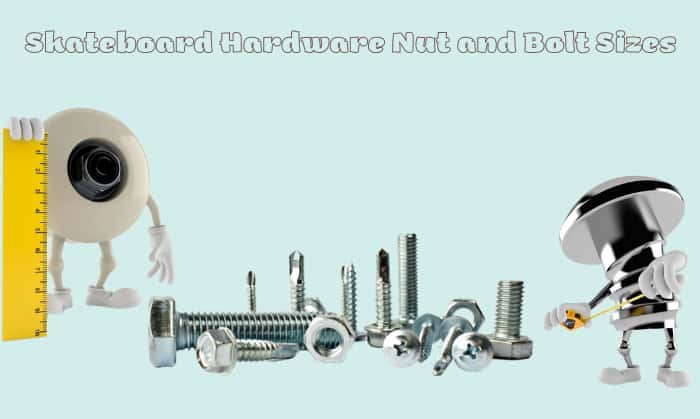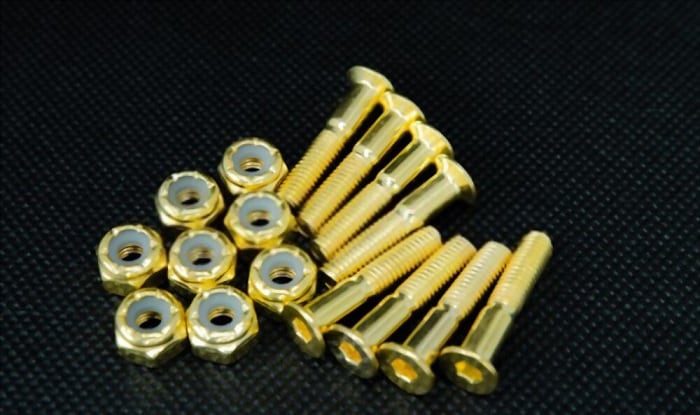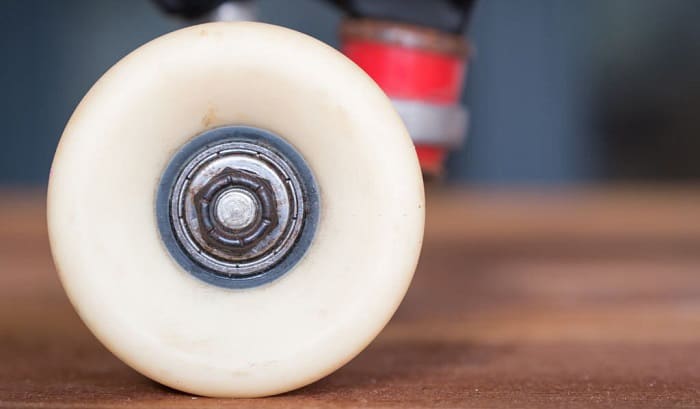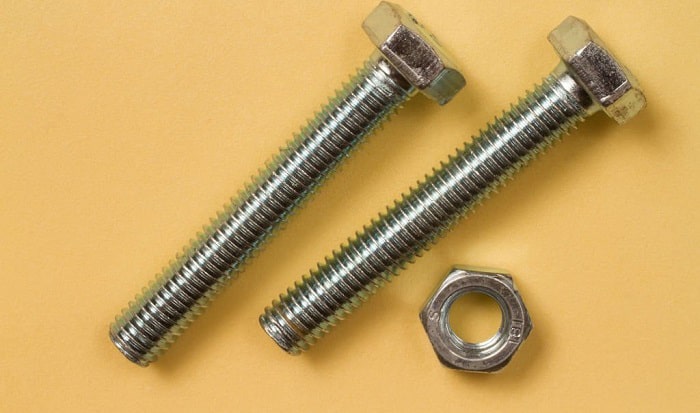As skateboarders, we always want our trucks, decks, and other components to be mounted well. Never do we want to suffer shaky rides because some parts are loose or not of the right size.
Therefore, a good set of skateboard hardware is necessary. Otherwise, we will have a messy ride every time.
So, let’s explore skateboard hardware nut and bolt sizes. Here, we will not only acquaint ourselves with their measurements but also the best skateboard setups for these figures.
Table of Contents
Skateboard Bolt Size
Most bolts in the skate stores come in a 10-32 size. “10” stands for the size established by the American National Standards Institute. On the other hand, “32” refers to the thread count of the bolt per inch.
Skateboard bolt length should be within the 1″ to 2″ range. And while it may not be much of an interval, increments within this size span fit specific configurations. Let’s start with the inclusion of riser pads.
If you use riser pads to prevent wheel bites or for any other purpose, kindly take note of this riser-to-bolt setup.
- 1 & 1/8″ Bolt size – Riser pads of 1/8″
- Bolts at 1 1/4″ – 1/4″ riser pads
- 1 & 1/2″ Bolts – 1/2″ risers
- 1 & 3/4″ Bolts – 3/4″ riser pads
- 2″ Bolt size – 1″ risers
As you can see, we only added fractions of an inch to the riser pads’ sizes to fit different bolts. Note that this configuration is more suited to a 7-ply skateboard with 1/8″ baseplates and 1/4″ nuts.
For skateboards with 8-ply or 9-ply decks, you can use screws size 1 & 1/4″ to 1 & 1/2″ regardless of the riser pad thickness. If you don’t use riser pads, you should be good with 1 & 1/8″ bolts.
However, there can be exceptions, such as some skateboards using bolts as short as 3/4″ for front adapters and others needing bolts beyond the 2″ mark for thicker riser pads. In these cases, consider asking fellow skaters or experts with relevant experience.
Skateboard Nut Size
Unlike the bolts, the nuts are more diverse in applications. If the bolts rest only on the deck and through the trucks, nuts are present in a couple more areas on the skateboard.
We use skateboard nuts in three components: the baseplate, wheels, and kingpin. Of these three, the baseplate nut is the smallest at 10/32, which matches the ANSI size of the bolts.
Meanwhile, skateboard wheels commonly have 5/16″ nuts. Lastly, the kingpins, with the thickest bolt girth, use 3/8″ nuts.
Do nut sizes on one skateboard component vary? No.
The nuts’ size we mentioned for each skateboard part remains the same across various brands and skateboard types. And for a skateboarder dealing with details as small as these, having a fixed size chart is beyond beneficial.
Skateboard Bolts and Nuts Vs Regular Hardware
For once, you might have thought of using the bolts and nuts you found at one corner of your house. Do they differ from the ones for skateboards? Yes.
Skateboard bolts come in certain thicknesses that fit firmly on the deck down to the trucks. And to ensure their quality, skateboard nut manufacturers ensure they produce nuts that lock securely even after a hundred vibrations on the skateboard.
Tools to Use on Hardware for Skateboard
It’s not enough that we use any driver or tool available to adjust the tightness of our skateboard’s hardware. With constant innovation, we’re thankful for the existence of the T-tool.
However, it becomes a different story if we buy a skateboard without it in the package. In such a case, we should turn to the following tools.
- A 9/16″ wrench – For skate trucks.
- A Phillips-head screwdriver – For skateboard deck bolts.
- A 3/8″ wrench – For the nuts of the deck.
- A 1/2″ wrench – For the skateboard wheels.
FAQs
1. Do skateboard bolts vary?
Besides size, skateboard bolts come in different sockets and head types. For bolts based on socket types, we have the Phillips and the Allen shapes, and for the head types, countersunk and raised heads.
- Phillips-head bolts come in a crossed-shape slot for the screwdriver. They’re one of the most convenient bolt types to use because of the broad availability of their drivers.
- Allen-head bolts are slightly less popular compared to the former. They have a hexagon-shaped head driven by an Allen key if you have a skate tool.
- Countersunk skateboard bolts are a popular type. This hardware comes with a flat-top finish to retain the deck’s smooth surface.
- On the other hand, raised heads are more likely to interfere with the rider because they cause unevenness on the skateboard’s deck. Nonetheless, they still work well for drop-through longboards.
2. Does skateboard hardware size matter?
Imagine using excessively long bolts on a pair of flexible skateboard trucks. More often than not, you can’t make smooth turns because the ends of the bolts hamper with the bends your truck hangers make.
With this, we need to be mindful of our hardware sizes. Below are a few benefits of keeping an eye on these figures.
- We get to prevent accidents caused by bolts sticking out.
- Grinding will feel smooth.
So, what’s the ideal excess length of skateboard bolts? Safety-wise, a 1/8″ spare length of the bolt sticking out from the nut will be reasonable.
3. Is wheel size relevant to skateboard truck bolt size?
To some extent, the wheel size can be a determining factor when choosing skateboard bolts.
Suppose you have skateboard wheels sized at 57 mm or higher. You don’t want them to wear out too soon because of wheel bites. Similarly, you also don’t want the deck to suffer wheel marks from riding.
So, you use riser pads. And by installing these parts, you also commit to using longer bolts to match the overall thickness of the deck, risers, and trucks combined.
In a few instances, 57mm wheels may not need risers as long as the trucks are tight.
Conclusion
Maintaining skateboards is not a walk in the park, but it makes us learn and understand why parts and components vary. In the end, we only benefit by improving our skateboard setups.
By learning about skateboard hardware nut and bolt sizes, we make ourselves ready for any revamp we will do with our skateboards. Remember where the bolt and nut sizes fit. And from there, you’ll know what pieces of hardware to buy, should you need them.

Hi, I am Charles Harris. I opened this site to write as much as I can about my biggest passion – skateboarding!
I started as a clumsy yet passionate rookie 10 years ago to now a still passionate yet much better skateboarder! But I have to tell you, the whole journey has always been fun and rewarding, indeed not without hardship.





